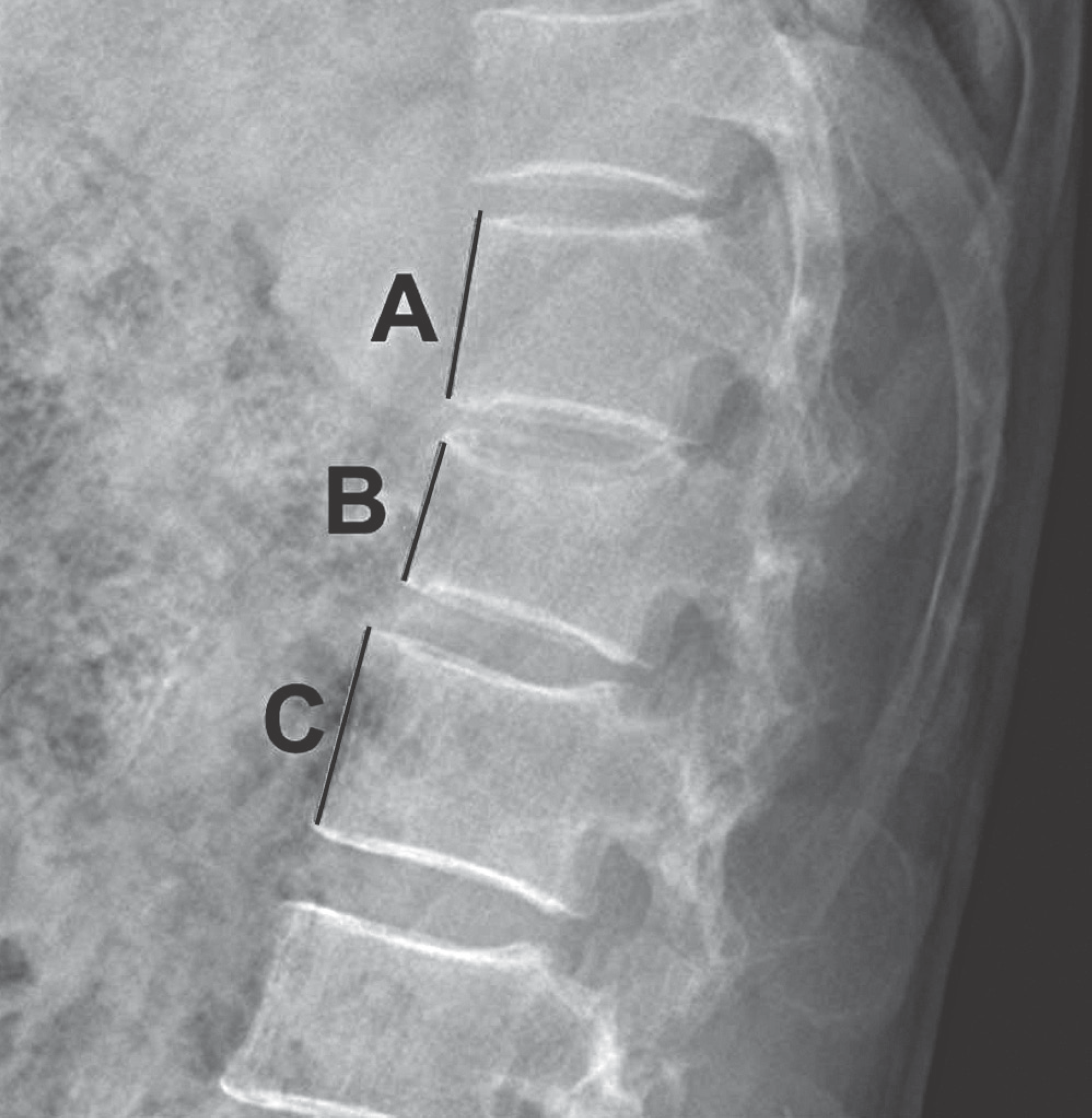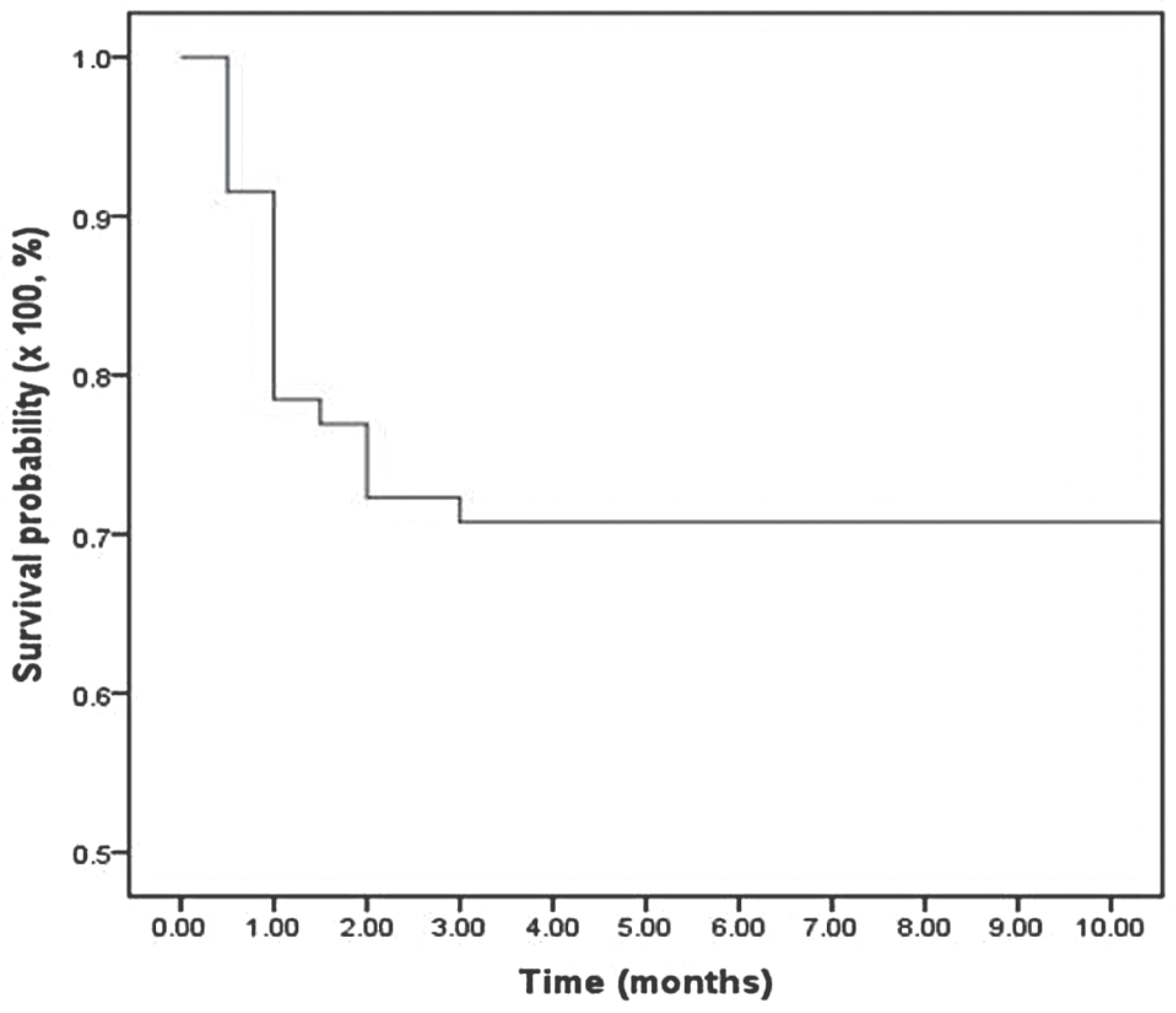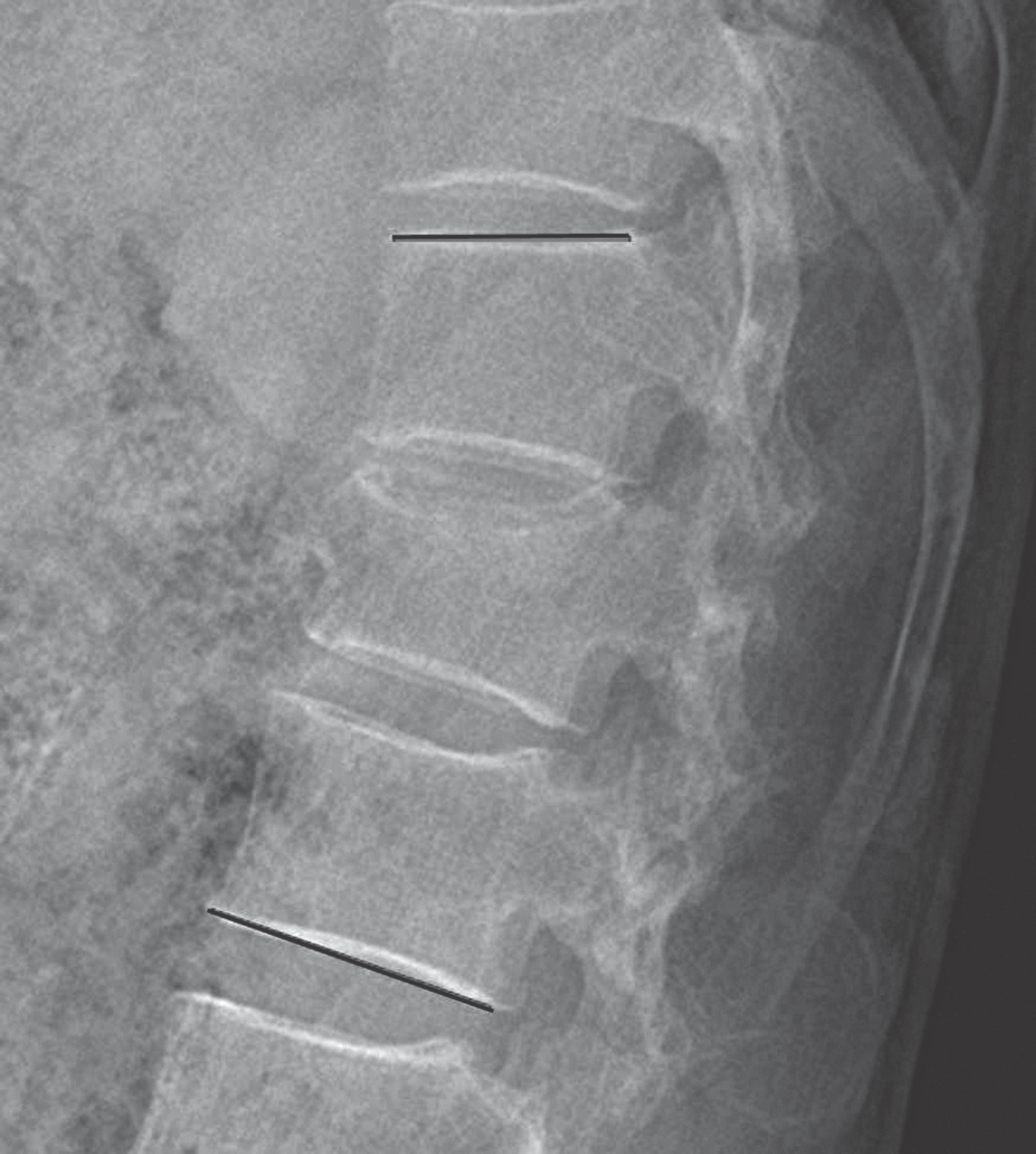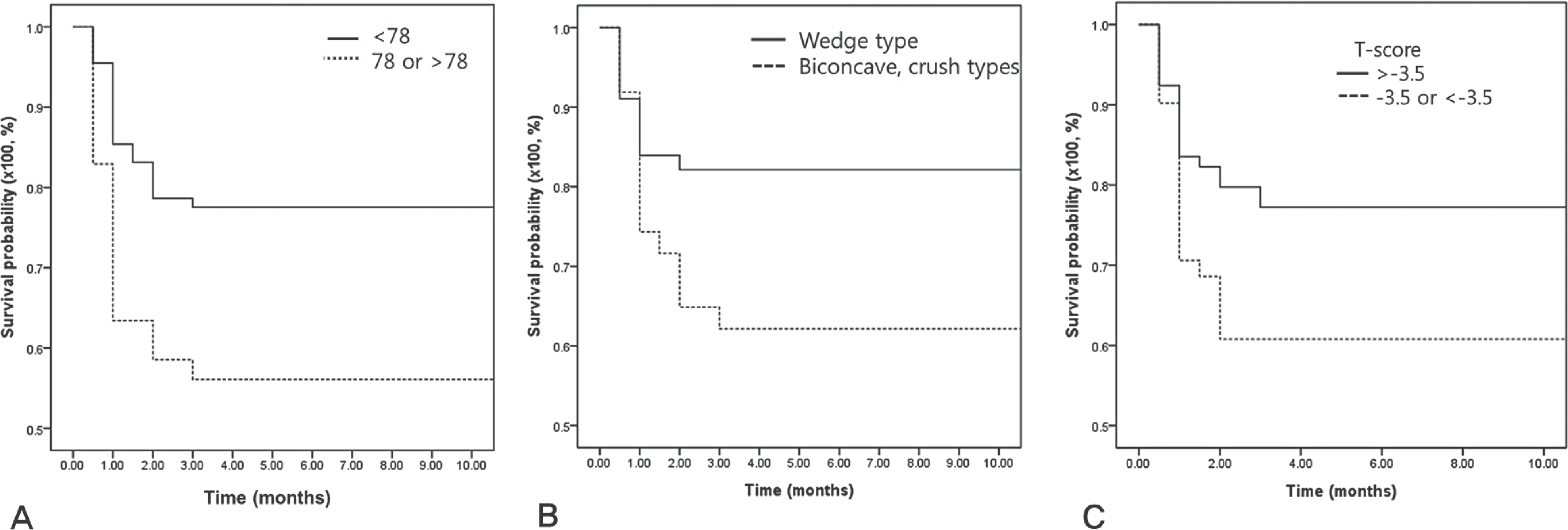Abstract
Objectives
To define the prognostic factors by analyzing the survival rates of osteoporotic vertebral fracture treated by conservative management.
Summary of Literature Review
Due to an increasing elder population, many recent studies of osteoporosis have been done; pointing out that osteoporotic vertebral fracture may produce serious complications. However, there is nothing obviously demonstrated in both the management and prognosis of the osteoporotic vertebral fracture.
Materials and Methods
Survival analysis was done for 130 patients who had undergone conservative management for a single level vertebral fracture. Univariant and multivariant survival analysis was done for age at trauma, sex, body mass index (BMI), bone mineral density (BMD), smoking, diabetic history, fracture level, fracture type, vertebral compression ratio and regional Cobb's angle.
Results
Survival rate for conservative management was 70.7%. Univariant analysis for survival rate revealed significantly inferior results for age over 78 (p=0.008), T score< -3.5 (p=0.047), and crush or biconcave type than wedge type (p=0.021). Only the age factor showed significance in multivariant analysis (p=0.025, Hazard ratio=2.08).
Conclusion
Conservative management in a single level osteoporotic vertebral fracture, showed a survival rate of 70.7% and age was the most important factor in conservative management. We should notice that age of more than 78 years is at high risk for failure in conservative management of vertebral fracture.
Go to : 
REFERENCES
1.Kim SW., Chung YK. Longterm follow-up osteoporotic vertebral fractures according to the morphologic analysis of fracture pattern. J Korean Soc Spine Surg. 2000. 7:611–7.
2.Melton LJ 3rd., Kan SH., Frye MA., Wahner HW., O'Fal-lon WM., Riggs BL. Epidemiology of vertebral fractures in women. Am J Epidemiol. 1989. 129:1000–11.

3.Reid DC., Hu R., Davis LA., Saboe LA. The nonoperative treatment of burst fractures of the thoracolumbar junction. J Trauma. 1988. 28:1188–94.

4.Westernborn A., Olsson O. Mechanics, treatment and prognosis of fractures of the dorso-lumbar spine. Acta Chir Scand. 1951. 102:59–83.
5.Schlaich C., Minne HW., Bruckner T, et al. Reduced pul-monary function in patients with spinal osteoporotic fractures. Osteoporos Int. 1998. 8:261–7.

6.Leech JA., Dulberg C., Kellie S., Pattee L., Gay J. Relationship of lung function to severity of osteoporosis in women. Am Rev Respir Dis. 1990. 141:68–71.

7.Kado DM., Browner WS., Palermo L., Nevitt MC., Genant HK., Cummings SR. Vertebral fractures and mortal-ity in older women: a prospective study. Study of Osteoporotic Fractures Research Group. Arch Intern Med. 1999. 159:1215–20.
8.Jung HW., Park JY., Kim KJ., Lee JC., Kim YI., Shin BJ. Conservative treatment of compression and stable burst fractures in the thoracolumbar junction: early ambulation Vs. late ambulation. J Korean Orthop Assoc. 2002. 37:483–8.

9.Suk SI., Lee CK., Kang HS, et al. Vertebral fracture in Osteoporosis. J Korean Orthop Assoc. 1993. 28:980–7.

10.Weinstein JN., Collalto P., Lehman TR. Thoracolumbar “burst” fractures treated conservatively: a long-term fol-low-up. Spine (Phila Pa 1976). 1988. 13:33–8.

11.Kim WJ., Kang JW., Park KY., Park JG., Jung SH., Choy WS. Clinical outcome of conservative treatment for osteoporotic compression fractures in thoracolumbar junction. J Korean Soc Spine Surg. 2006. 13:240–6.

12.Diamond TH., Champion B., Clark WA. Management of acute osteoporotic vertebral fractures: a nonrandomized trial comparing percutaneous vertebroplasty with conservative therapy. Am J Med. 2003. 114:257–65.

13.Garfin SR., Yuan HA., Reiley MA. New technologies in spine: kyphoplasty and vertebroplasty for the treatment of painful osteoporotic compression fractures. Spine (Phila Pa 1976). 2001. 26:1511–5.
15.Park HG., Kim MH., Yoo MJ, et al. Complications after vertebroplasty of treatment for compression fracture with osteoporosis. J Korean Fracture Soc. 2003. 16:534–40.

16.Wenger M., Markwalder TM. Re: Percutaneous vertebroplasty for pain relief and spinal stabilization. Spine (Phila Pa 1976). 2000. 25:2968–9.
17.Bengner U., Johnell O., Redlund-Johnell I. Changes in inci-dence and prevalence of vertebral fracture during 30 years. Calcif Tissue Int. 1988. 42:293–6.
18.Lindsay R., Burge RT., Strauss DM. One year outcomes and costs following a vertebral fracture. Osteoporos Int. 2005. 16:78–85.

19.Grados F., Depriester C., Cayrolle G., Hardy N., Deramond H., Fardellone P. Long-term observations of vertebral osteoporotic fractures treated by percutaneous vertebroplasty. Rheumatology. 2000. 39:1410–4.

20.Riggs BL., Melton LJ 3rd. The worldwide problem of osteoporosis: insights afforded by epidemiology. Bone. 1995. 17:505–11.

21.Cyteval C., Sarrabere MP., Roux JO, et al. Acute osteoporotic vertebral collapse: open study on percutaneous injection of acrylic surgical cement in 20 patients. AJR Am J Roentgenol. 1999. 173:1685–90.

22.Yamazaki K., Kushida K., Kin K, et al. Bone mineral density of the spine and femoral neck fracture in normal japanese subjects using X-ray absoptiometry. J Bone Miner Res. 1989. 4:228.
23.Lyritis GP., Mayasis B., Tsakalakos N, et al. The natural history of the osteoporotic vertebral fracture. Clin Rheumatol. 1989. 8:66–9.

24.Ismail AA., Cooper C., Felsenberg D, et al. Number and type of vertebral deformities: epidemiological characteristics and relation to back pain and height loss. European Vertebral Osteoporosis Study Group. Osteoporos Int. 1999. 9:206–13.
25.Yamato M., Nishimura G., Kuramochi E., Saiki N., Fujioka M. MR appearance at different ages of osteoporotic compression fractures of the vertebrae. Radiat Med. 1998. 16:329–34.
26.Kanchiku T., Taguchi T., Kawai S. Magnetic resonance im-aging diagnosis and new classification of the osteoporotic vertebral fracture. J Orthop Sci. 2003. 8:463–6.

27.Sohn JM., Kim KW., Ha KY., Ha NK., Kim YH., Kim JH. Risk factors for the progressive osteoporotic spinal fracture. J Korean Soc Spine Surg. 2009. 16:153–9.

28.Ahn DK., Lee S., Choi DJ., Park HS., Kim KS., Kim TW. The efficacy of kyphoplasty on osteoporotic vertebral compression fracture: a 1-year follow-up study. J Korean Soc Spine Surg. 2009. 16:79–882.
Go to : 
 | Fig. 1.Measurement of vertebral compression ratio by the following formula, [(A+C)/2-B]/[(A+C)/2]. ∗A: anterior vertebral height of upper vertebra, B: anterior vertebral height of fracture level, C: anterior vertebral height of lower vertebra. |
 | Fig. 3.The Survival rate was 91.5% at 2 weeks, 78.5% at 1month, 72.3% at 2months, and 70.7% at 3months. |




 PDF
PDF ePub
ePub Citation
Citation Print
Print




 XML Download
XML Download